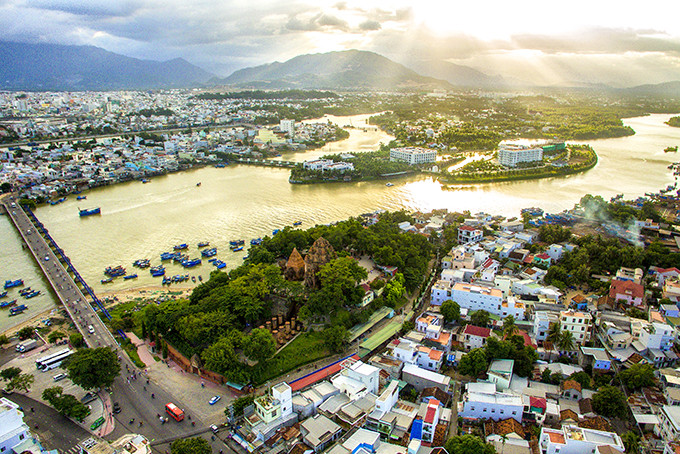
Infrastructure development will be focused in Nha Trang City in the coming years to promote its position as an urban center...
Infrastructure development will be focused in Nha Trang City in the coming years to promote its position as an urban center of Khanh Hoa Province towards the target of becoming a centrally-governed type 1 city by 2025, according to Nha Trang City leader.
Modern but still lacking
According to the leader of Nha Trang City People's Committee, there are presently more than 600 roads, 1,700 alleyways, 17 road bridges and 2 coach stations in the city. In addition, there are 4 inner-city car parks and 24 parking lots along the beach. Most urban electricity supply systems are connected to the national grid. Telecommunication cables are mainly underground in new urban areas. There are more than 20,000 sets of high-pressure public lights, of which 34% are on main roads. The urban water supply system has a capacity of 90,000 m3/ day and night, basically meeting the clean water demand of local residents. The drainage and wastewater treatment system is relatively good with a capacity of 40,000 m3/ day and night. There is a landfill, 12ha, handling 550 tons of garbage/ day.

|
According to the leader of Department of Construction, there are about 18,000 urban trees in Nha Trang City. The number is still lower than required by the Ministry of Construction, especially after Typhoon Damrey in 2017 when many trees were damaged and uprooted. Therefore, is necessary to add more trees to reach the target of 5m2 of trees/ person. The city has more than 100 housing projects in 10 new urban areas in the west of the city and 5 apartment complexes (commercial and social housing), the technical infrastructure systems of which have been basically completed. When put into use, such projects are expected to add about 26 million square meters of floor space, basically meeting the housing demand for 521,000 people.
In addition to strengths and advantages, there still remain some limitations in urban technical infrastructures such as narrow inner-city streets impacting socio-economic growth and travel; telecommunications and power lines mainly installed overhead on medium and low voltage systems; lack of synchronous infrastructures and investment in hazardous solid waste treatment system and domestic waste treatment plants meeting environmental standards, etc, according to Le Huu Tho, Secretary of Nha Trang City Party Committee.
Several solutions taken
To meet the targets mentioned above, according to the leader of Nha Trang City, in the coming time, the Party Committee at all levels is required to focus leadership and direction on urban technical infrastructure development considered as among key tasks of the city political system. The city will double-check to assure synchronous connection of road and inland waterway traffic planning; train stations, sea ports, tourist ports and smart parking lots; promote contribution of ideas and suggestions to projects, assessment and approval processes to adapt to local socio-economic growth strategies; urban design research in some coastal zones and estuaries; and reduce high density of skyscrapers to ease pressure on urban traffic infrastructures.
The city needs to focus resources and scientific and technological application on the management and development of technical infrastructures synchronously. Specifically, it is necessary to invest selectively with focus on key projects; make investment planning for projects based on order of priority, balance annual capital sources in a reasonable way; synchronize investment processes, combine work on transport infrastructures, underground electrical system and telecommunication network; and develop urban greenery and parks to enhance natural landscape.
Obstacles in site clearance, compensation and resettlement are among causes for projects falling behind schedule. In the coming years, the city will prioritize the construction of infrastructures for resettlement land fund development, select suitable places designed for resettlement zones for homes affected by key projects in the city center; speed up the formulation, appraisal and approval of compensation land cost to help people stabilize their lives; strengthen the mobilization under the motto “The State and people work together” for the development of urban technical infrastructures.
To implement the above solutions, Nha Trang City needs the concern, leadership and direction of the Provincial Party Committee, People's Council and People's Committee and the coordination of local departments and agencies to focus resources on the synchronous development of urban technical infrastructures towards the target of Khanh Hoa becoming a centrally-governed type 1 city by 2030, according to Le Huu Tho.
Van Ky
Translated by N.T






